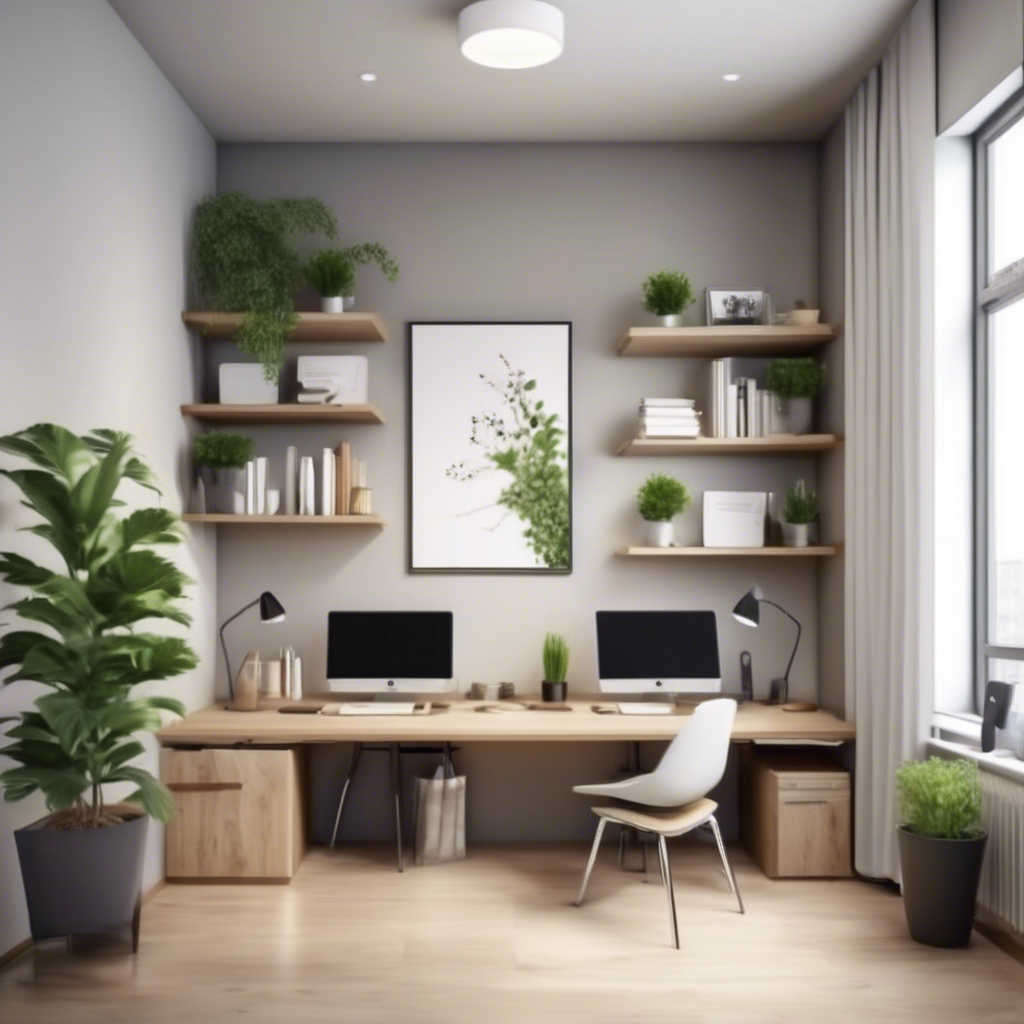Tips for maximizing space and light in a small office without windows
Decorating a small office without windows can present a unique set of challenges. However, with the right tips and tricks, you can create a productive and inviting workspace that maximizes space and light effectively. By implementing clever design strategies and utilizing the available resources efficiently, you can transform your windowless office into a bright and inspiring environment that boosts creativity and focus.
Assess Your Lighting Needs
Assessing your lighting requirements is the first step in decorating a small office without windows. Since natural light is limited or non-existent, it’s essential to invest in artificial lighting that mimics natural light as closely as possible. Opt for full-spectrum LED bulbs that provide bright, daylight-like illumination to create a more natural and comfortable work environment. Additionally, consider incorporating task lighting with adjustable desk lamps to illuminate specific work areas effectively.
Choose Light Reflective Colors
When selecting colors for your windowless office, opt for light, neutral shades to maximize the reflection of artificial light and create a sense of spaciousness. Light colors such as white, cream, soft gray, or pastel tones can help bounce light around the room, making it appear brighter and more open. Avoid dark, heavy colors that can absorb light and make the space feel more confined. You can add pops of color through accessories or artwork to inject personality into your office without overwhelming the space.
Utilize Mirrors to Create Illusion
Mirrors are an excellent design tool for enhancing light and creating the illusion of space in a windowless office. Strategically placing mirrors on the walls can reflect artificial light, making the room feel larger and airier. Consider placing a large mirror opposite a light source to maximize light reflection or create a gallery wall of smaller mirrors to add visual interest and brightness to the space. Mirrors not only enhance the aesthetic appeal of your office but also contribute to a more luminous and spacious atmosphere.
Opt for Multi-Functional Furniture
In a small office without windows, space optimization is key. Invest in multi-functional furniture pieces that serve dual purposes to maximize functionality while minimizing clutter. Consider using a desk with built-in storage compartments, wall-mounted shelving units to free up floor space, or a foldable table that can be expanded or collapsed as needed. Choose furniture with sleek, minimalist designs to maintain a sense of openness and prevent the space from feeling crowded.
Incorporate Plants for Natural Touch
While a windowless office may lack natural light, you can still introduce elements of nature by incorporating houseplants into your decor. Select low-light, low-maintenance plants such as snake plants, pothos, or ZZ plants that can thrive in artificial light conditions. Not only do plants add greenery and visual appeal to your workspace, but they also help purify the air and create a more vibrant and inviting atmosphere. Place plants on shelves, desks, or hanging planters to bring a touch of nature indoors.
Create a Functional Layout
Creating a well-thought-out layout is crucial in maximizing space and productivity in a small office without windows. Arrange furniture in a way that promotes easy movement and workflow efficiency. Keep pathways clear and ensure that essential work areas are easily accessible. Consider using modular furniture that can be rearranged to adapt to your changing needs or implementing a workstation layout that separates different work tasks effectively. By optimizing your office layout, you can create a functional and organized space that enhances your overall work experience.
Decorating a small office without windows requires creativity, strategic planning, and a focus on maximizing light and space. By incorporating these tips into your design approach, you can transform your windowless workspace into a bright, welcoming environment that inspires productivity and creativity. Remember to personalize your office decor to reflect your unique style and preferences while maintaining a balance between aesthetics and practicality. With the right design choices and mindful organization, you can create a small office that feels spacious, well-lit, and conducive to your work needs.
Utilizing color psychology and artificial lighting techniques for enhancing productivity in windowless workspaces
Color Psychology and Artificial Lighting for Windowless Workspaces
In a modern office setting, having a small office with no windows can be quite common. While natural light is beneficial for productivity and well-being, there are ways to enhance the ambiance and functionality of a windowless workspace through color psychology and artificial lighting techniques. By strategically choosing colors and implementing proper lighting, you can create a stimulating and productive environment that can boost morale and creativity among employees.
Importance of Color Psychology
Color psychology plays a crucial role in influencing human emotions, behaviors, and productivity levels. In a windowless office, the choice of colors on the walls, furniture, and decor can have a significant impact on the overall atmosphere. Different colors evoke different feelings and can affect people in various ways. For example:
- Blue is known for promoting calmness and improving focus.
- Green is associated with harmony, balance, and productivity.
- Yellow can help stimulate creativity and optimism.
- Red is energizing and can increase pulse rates and alertness.
When decorating a small office with no windows, it is essential to consider the psychological effects of colors on mood and productivity. By incorporating the right colors based on the desired outcome, you can create a conducive work environment that enhances concentration and creativity.
Choosing the Right Color Palette
When selecting colors for a windowless workspace, it’s crucial to opt for a balanced color palette that resonates with the company’s culture and the nature of work being done. Here are some tips for choosing the right color scheme:
- Neutral Colors: Utilize neutral hues like white, beige, or light gray as a base to create a sense of spaciousness and cleanliness.
- Accent Colors: Introduce accent colors like blues, greens, or yellows through furniture, artwork, or accessories to add pops of color and stimulate productivity.
- Avoid Dark Colors: Steer clear of dark colors like black or deep brown, as they can make the space feel cramped and dreary.
By carefully selecting a harmonious color palette, you can transform a windowless office into a vibrant and energizing workspace that fosters creativity and boosts productivity.
Harnessing Artificial Lighting Techniques
In the absence of natural light, artificial lighting becomes paramount in illuminating and enhancing the ambiance of a windowless office. Proper lighting can mimic the effects of natural light and create a bright and inviting atmosphere. Here are some artificial lighting techniques to consider:
- LED Lighting: Opt for LED lights that offer bright, energy-efficient illumination and adjustable color temperatures to mimic natural light throughout the day.
- Task Lighting: Incorporate task lighting such as desk lamps or overhead lights to provide adequate lighting for specific work tasks and reduce eye strain.
- Ambient Lighting: Use ambient lighting fixtures like wall sconces or floor lamps to create a warm and inviting environment that complements the chosen color palette.
By combining artificial lighting techniques with a thoughtfully selected color scheme, you can enhance the functionality and aesthetics of a windowless office, creating a space that promotes productivity and well-being among employees.
Decorating a small office with no windows requires a thoughtful approach that leverages color psychology and artificial lighting techniques to optimize the workspace for productivity and comfort. By harnessing the power of colors and lighting, you can transform a windowless office into a vibrant and inspiring environment that motivates employees and enhances overall performance.
Conclusion
In today’s fast-paced work environments, many professionals find themselves spending significant amounts of time in small offices without windows. While the lack of natural light can pose challenges, there are various strategies that can be employed to create a productive and inspiring workspace. By maximizing space utilization, incorporating color psychology principles, and implementing strategic lighting solutions, individuals can transform windowless offices into inviting and efficient work environments.
When it comes to maximizing space and light in a small office without windows, one of the key considerations is efficient furniture placement. Opting for multifunctional furniture pieces that serve dual purposes, such as storage ottomans or wall-mounted desks, can help free up floor space and create a sense of openness. Additionally, choosing light-colored furniture and accessories can contribute to a brighter ambiance in the absence of natural light.
Another crucial aspect to consider is the strategic use of mirrors to create the illusion of space and reflect artificial lighting. Placing mirrors strategically across from light sources can help bounce light around the room and make the office feel larger and airier. Moreover, incorporating reflective surfaces like glass or metallic finishes can further enhance the brightness and visual depth of the space.
Color psychology plays a significant role in influencing mood, productivity, and creativity in interior spaces, including windowless offices. When decorating a small office with no windows, opting for light and neutral tones such as whites, creams, and pastels can help create a sense of airiness and openness. Light colors reflect artificial light more effectively, making the space feel brighter and more inviting. Additionally, adding pops of vibrant colors through accessories or accent walls can inject energy and creativity into the workspace.
Artificial lighting is a critical element in enhancing the functionality and aesthetics of a windowless office. To combat the lack of natural light, it is essential to incorporate a combination of ambient, task, and accent lighting. Ambient lighting, such as overhead fixtures or wall sconces, helps illuminate the entire space evenly. Task lighting, such as desk lamps or under-cabinet lights, provides focused illumination for specific work areas. Accent lighting, like decorative floor lamps or string lights, adds visual interest and can create a cozy atmosphere in the office.
By implementing these tips for maximizing space and light, utilizing color psychology principles, and incorporating artificial lighting techniques, individuals can create a welcoming and efficient workspace in a small office without windows. With a thoughtful approach to design and a focus on enhancing productivity and well-being, even the most challenging work environments can be transformed into inspiring and functional spaces.



